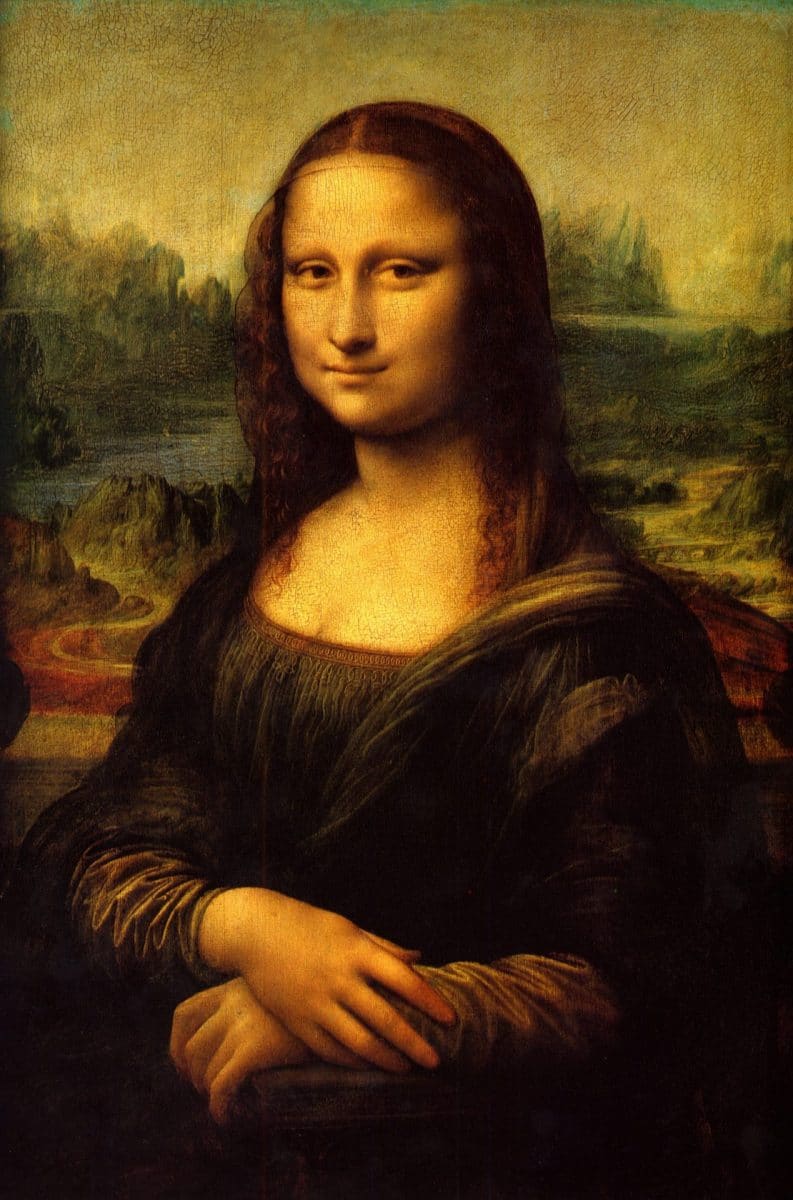The Rubell Museum Miami

One of the most collected artists by the Rubells, I would venture, might be Robert Colescott (1925-2009). Colescott combines the Rubell’s love of irreverent art and their support of contemporary art that helps to paint a picture of modern America. Of course that has always included black artists, even before they occupied such a central position in the artistic narrative of the moment.
It would seem as though the Rubells own at least 10 pieces by Robert Colescott, although fewer were on display at the newly opened Rubell Museum in December 2019. The paintings and drawings by Colescott were nonetheless displayed together, without any other artists’ works, reinforcing the importance of the work.
Colescott’s artwork could be described as satirical, and boundary-pushing in terms of subject matter makes this artist worth a closer look in order to parse out its multi-layered complexity and be able to fully appreciate it. Satire and surrealism play a significant role in many of Colescott’s paintings and help him to transmit his message.
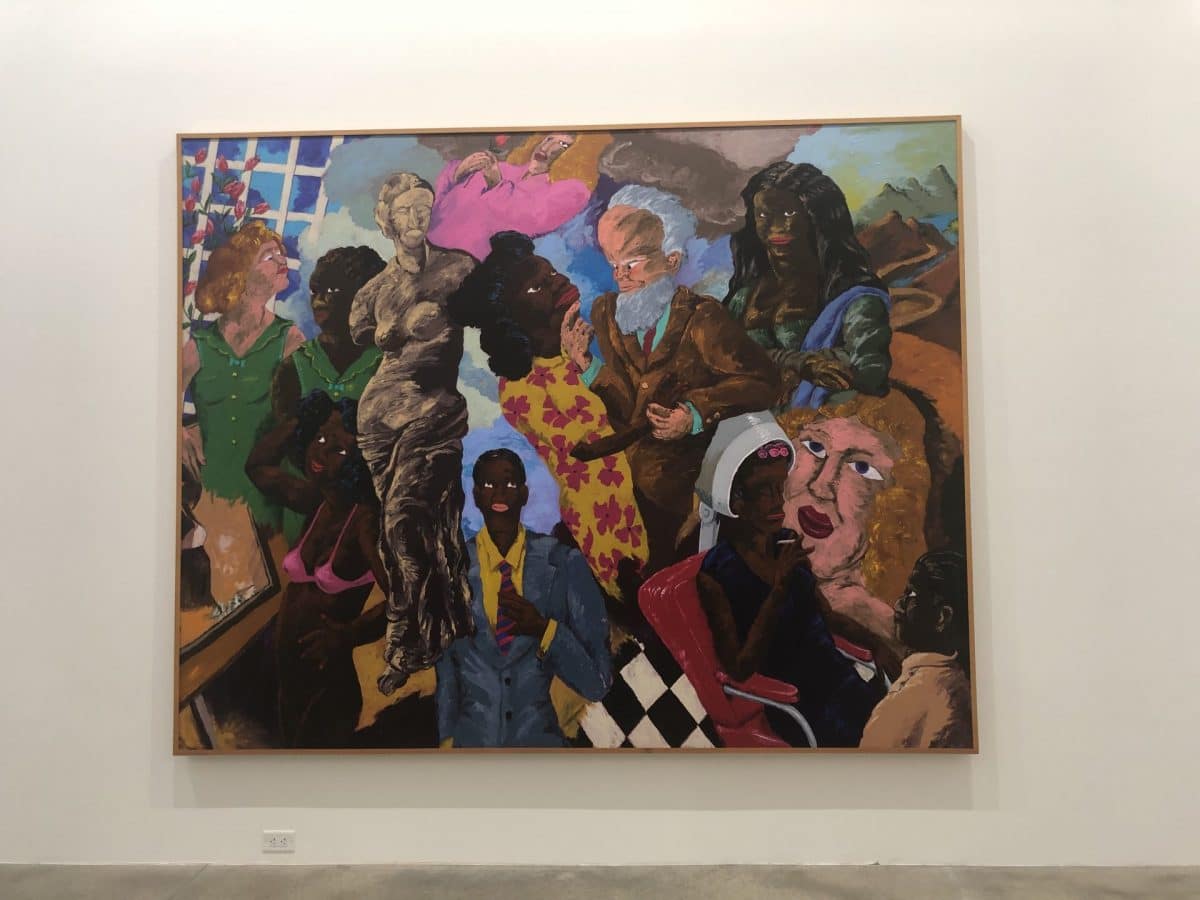
Starting with Pygmalion, we see a mix of black and white figures in a mix of scenes, all placed together on one canvas. In terms of references to classical art, there is a “black” Mona Lisa in the upper right hand corner, complete with her folded arms, mysterious smile and trail leading into distant mountains.
Below “Black Mona Lisa” is a white woman disproportionate to the rest of the images, in front of which another black woman sits under a salon dryer observed by a man. Observation is a theme in the piece, with many of the subjects staring at each other or out at the viewer.
Knowing the title, Pygmalion, is a reference to a sculptor who fell in love with his statue, one may notice that many of the items in the painting are indeed conceptual or literal creations.
There is a version of the Venus de Milo, one of the most famous sculptures of antiquity just off to the left. Surrounding her are the dancing woman (a man in a suit dances with a woman in a floral dress, caressing her chin in a manner suggesting ownership or perhaps a repositioning as someone learning to dance – perhaps a reference to “My Fair Lady”), in addition, a young man with a backpack and a woman posing in a pink bra also appear.
Clearly Colescott is having fun with the work, as he mixes together metaphorical concepts of self-improvement (or improvement by others) with the dance lesson, the backpacked boy and the salon scene, with quintessential feminine “masterpieces” from the Western European tradition.
This artificial amalgam of known cultural references as well as novel concepts creates an opportunity for Colescott to exercise his creativity and continue the exploration of themes of race, identity and cultural hegemony.
Colescott’s Ode to Joy (European Anthem) from 1997 suggests a level of opulence with a cupid-like figure in one corner and an artist’s palette in the other, but a foundation of hamburgers and a pot of gold at the center.

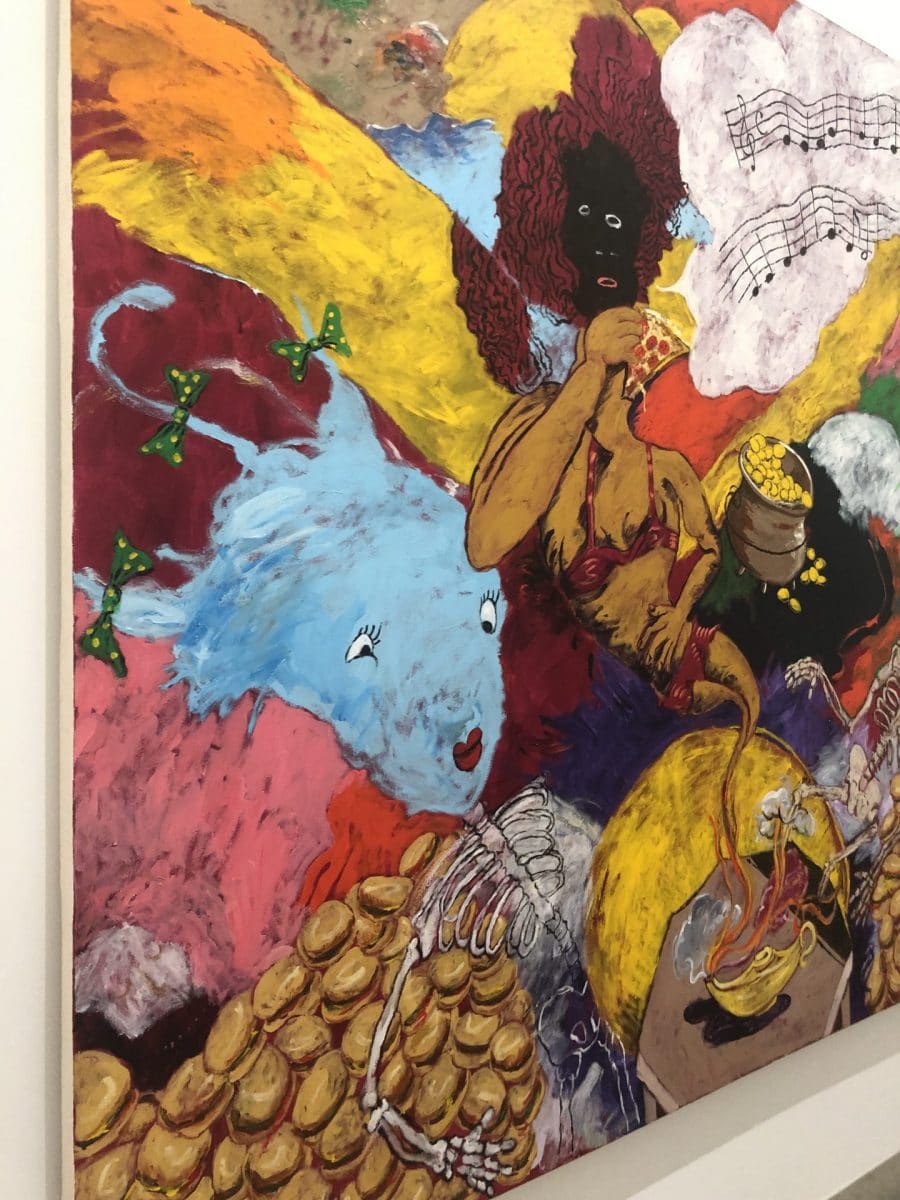
Like Pygmalion, a sense of depth and perspective is missing in the piece. Ode To Joy features a genie (possibly wearing blackface), as well as multiple skeletons with blue cotton-candy heads.
I wonder what Colescott is trying to express with Ode. Is the singing genie supposed to represent Europe itself? It seems to be a young country, of disparate parts, flanked (or created by) the skeletons of formerly great European empires? Is it supported by “Hamburgers” and gold (perhaps signifying the US?). It’s all a bit mysterious, but is fun to delve into the possible symbolism.
Moving away from geopolitics, the piece “Moonlighting in Porno” offers a contrast.
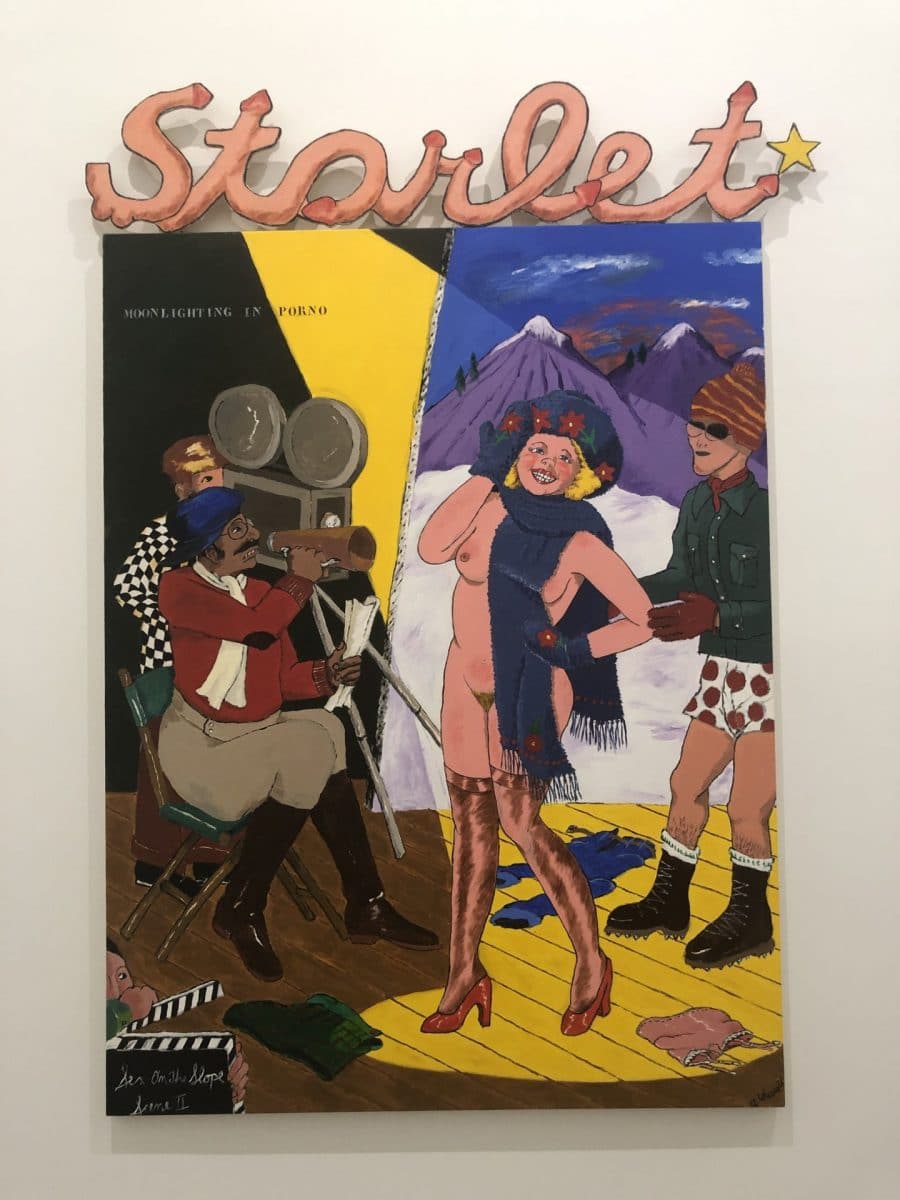
The piece is painted in a style that predates most of the other works in the show, and seems to have a playful and one-dimensional aspect to its message. Yet, if one wants to simply take in another work by Colescott, this is an opportunity to do so. Most of all, take note the lettering of “Starlet”… have you ever seen a font made of penises before? Given that Colescott made the female actress nude (and was often accused of objectifying the female body in his work) and has the male wearing boxers, it’s nice to see that he’s actually not shying away from the male member.
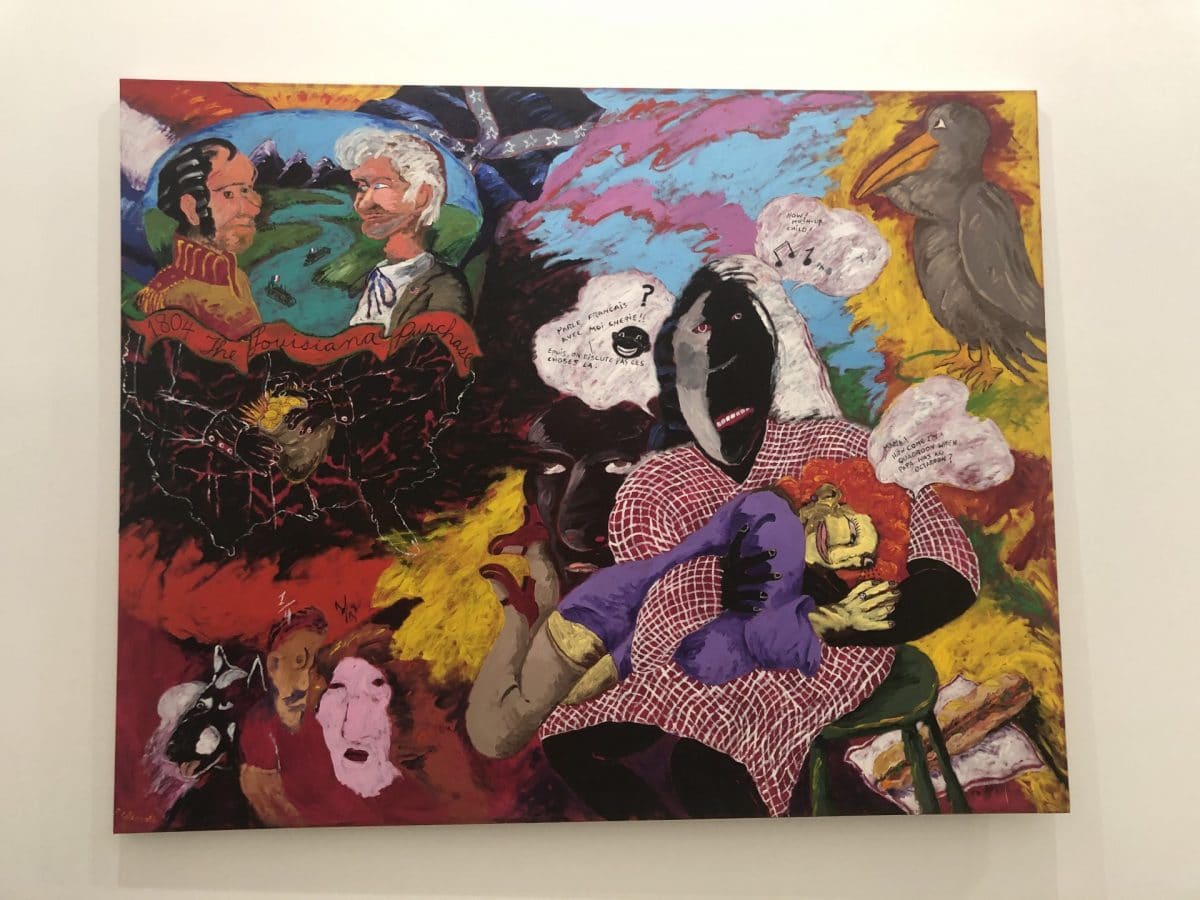
Sunset on the Bayou is another multi-layered piece with multiple vignettes on one canvas. The upper left is labeled in red “The Louisana Purchase” and the arms of the two white men exchange a bag of gold. This “purchase” of the majority of our country does suggest that it “belonged” to these European men to begin with… but did it? And I wonder of the exact connection of this image and how it connects with the main message of the piece. There are two figures and a dog i the lower left-hand corner with fractions above their heads (only for the humans, not the dog). “1/4” and “1/32” – one can only imagine this is a reference to the concept of the “One Drop Rule” which wished to define and legislate the social construct of race.
Race seems to be the main theme of this painting. Note the text in the painting.

“Mama! How come I’m a quadroon when Papa was an octaroon?”

“Speak French with me darling! But really, we don’t discuss those things…”
Mother, whose face may illustrate her racial heritage (one part white, one part black) occupies a large portion of the painting. Sitting on a stool, with a sandwich (possibly a po’boy?) behind her, she is cuddling (or about to punish) her daughter.

This piece, as with the rest of Colescott’s work, is hard to fully grasp. Reading Robert Colescott in his own words (in the above wall label) gives us an idea of how Colescott was trying to spark conversations with his work. He is seen to be a predecessor of other famous black artists such as …
Roberta Smith’s obituary of Colescott in the New York Times does an excellent job describing him (and puts my paltry descriptions of his work to shame)
While Mr. Colescott’s work was overtly political and multicultural, it was often at odds with the academic earnestness of such approaches. In his disregard for simplistic dualities regarding race and sex , he helped set the stage for transgressive work by painters like Ellen Gallagher, Kerry James Marshall, Sue Williams and Carroll Dunham and multimedia artists like Kara Walker, William Pope.L and Kalup Linzy. When asked if he didn’t feel an obligation to serve “the black community,” Mr. Colescott replied, “The way that one serves is to serve art first,” adding that “the way you serve art is by being true to yourself.”
Roberta Smith for the New York Times
Colescott paved the way for other artists we revere today. In his work, by trying to poke fun at stereotypes and racism he is trying to take away their negative power. Most of all, Colescott saw that bringing these ideas into the light would give people an opportunity to talk about their feelings on this challenging subject – one that continues to require attention and work today.

